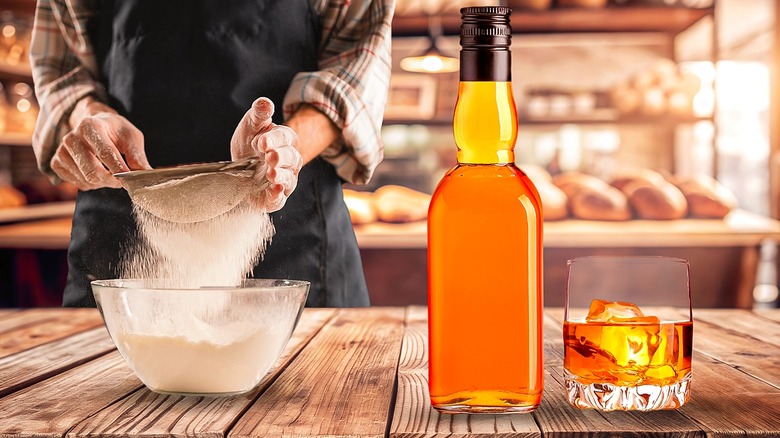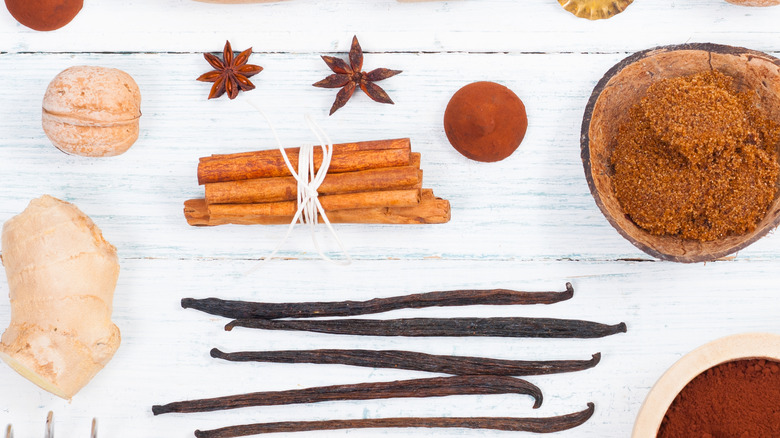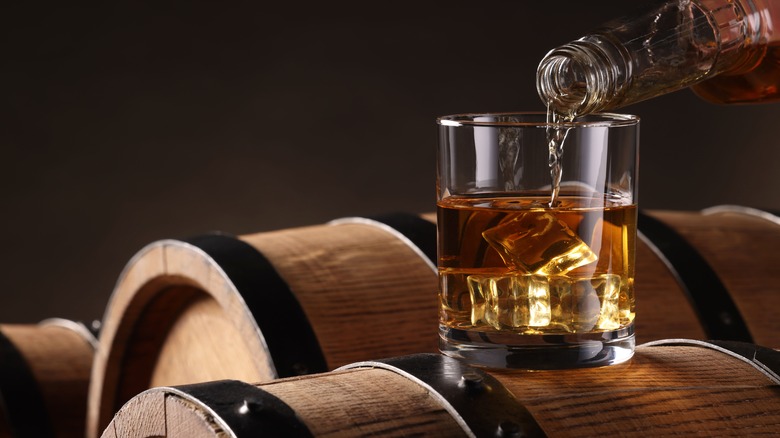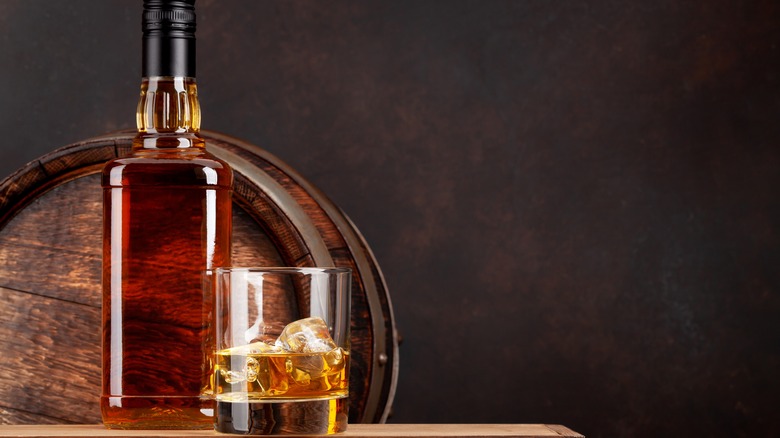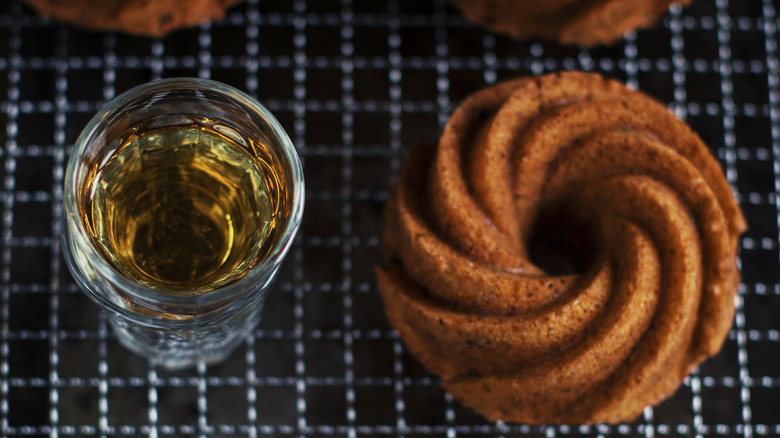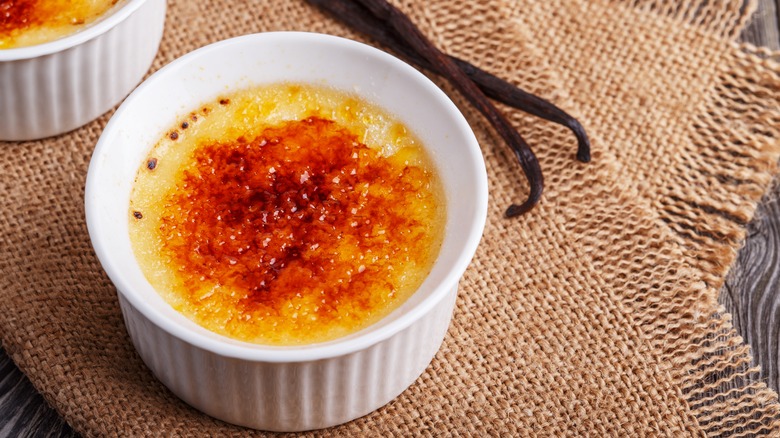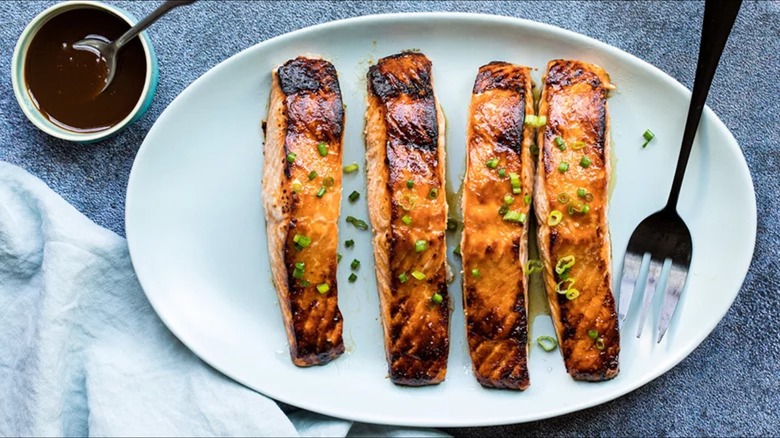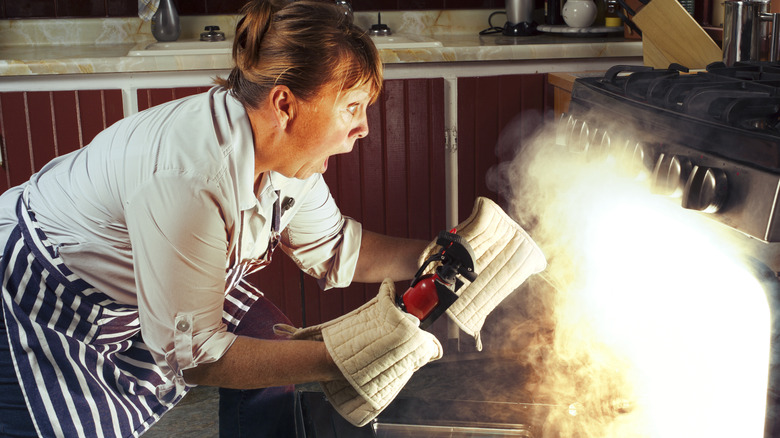8 Must-Know Tips For Baking With Bourbon This Fall
As the leaves turn this fall and you start craving cozy smells and flavors coming from your oven, you're going to want to know some tips for incorporating bourbon into your dishes. Bourbon can infuse almost anything you want to bake with a subtle sweetness, bold flavor, and cozy warmth. However, you can easily ruin your dish or even cause a fire if you don't know what you're doing.
Baking with bourbon requires a balance of both chemistry and flavor. Once you get those right, you're good to go. What better way to learn how to bake with bourbon than to get advice from people who teach how to bake with it? We got insight from four chefs who teach classes about using bourbon for baking and cooking.
Chef Lisa Counts is the executive chef and owner of The Chopping Block in Chicago, Illinois. Chef Sara Salzinski is also from The Chopping Block, where she's a chef instructor and curriculum coordinator. We also got some good advice from chef Matt Finarelli, the owner and an instructor at Red Jacket Cooking School, which provides both online classes and in-home cooking classes in the Washington, D.C. area. Finally, we spoke with chef Matthew May, the owner and a culinary instructor at Matthew May's Teaching Kitchen in Virginia Beach, Virginia. The eight tips these chefs provided for us will take you far when it comes to making your bourbon-infused recipes even better.
Taste the bourbon to decide if it matches the dish you're making
If you're baking with bourbon this fall, one of the first things you need to do is to taste it to make sure it matches the flavor profile of your dish. We probably won't have to twist your arm to get you to sniff and sample all the bourbons in your cupboard to see if they fit. If they don't, you might want to do a little research to find one that does.
The bourbon range of flavor notes includes nutty, smokey, woody, sweet, spicy, and fruity, among others. For some baking applications, sweet notes like chocolate, vanilla, butterscotch, or marshmallow may be what you're looking for. You could intensify the fruit flavors with notes like cherry, orange, berry, or apple. Plus, there are plenty of bourbons that have a hint of spice, like cinnamon, cloves, or allspice. Wheat bourbons provide a sweet and warm note, while rich dishes work well with bourbons that have brighter flavors, and ones with malted barley work nicely when baking dishes featuring grains.
While pairing the notes with the dish is one option, the other option is to find a bourbon that you like with everything, like chef Lisa Counts does. She says, "I look for bourbons with vanilla and caramel notes for baking, but it also pairs well with meats." So, don't think that you have to go for savory notes just because you're not cooking something sweet.
Bourbon quality matters
You want to choose your cooking bourbon just like you would your drinking bourbon. Quality matters whether you're drinking it or eating food cooked with it. If you use a bottle that's been at the back of your cabinet because it's too smokey and you don't like to drink it, guess what's going to happen when you add it to your baked dish? Yep, you're going to be adding those flavors to your food. So use a good bourbon brand.
The chefs we talked to agreed that quality matters when baking with bourbon. Chef Sara Salzinski has this advice: "Choose a quality bourbon, one you would actually drink, like our favorite Bull Run Bourbon from Portland, which has both sweet and spicy notes."
Likewise, chef Matt Finarelli says, "What makes a bourbon (or any spirit, or any wine, or any beer) a good selection when choosing one to cook with ... it has to be one you would also gladly drink any time. There is no reason to cut corners and use a bourbon that you think is terrible and have that be your 'cooking bourbon.'"
He mentioned two main problems with using a bourbon you don't like. "First, it simply pollutes your food with a flavor you don't like. Secondly, it means you have a bottle of bourbon sitting around in your cabinet/bar that you actively dislike." Pass it off to a friend if you don't like it. Don't put it in your food.
Consider the price
When it comes to baking with bourbon, you want to reach a happy medium with price. Don't go so cheap that you end up with a negative flavor, but don't waste your most expensive bourbon on baking, either.
On one end of the spectrum, you've got your cheap bourbons. Granted, there are some bourbons at lower price points that you might like. However, chef Sara Salzinski suggests, "Don't go with cheap just because you will cook with it!" If you don't regularly drink bourbon and are choosing a lower-priced one for baking purposes, you'll want to read some reviews before you end up with something that will infuse your baked dish with something that tastes more like a cleaner than a drink. Bourbons are certainly not all equal.
On the other end of the spectrum are the more expensive bourbons that may have an excellent flavor but may not really be necessary to make a great baked bourbon dish. Chef Matt Finarelli says, "I like drinking some expensive bourbons that can run well over a few hundred dollars a bottle, but it would simply be ludicrous to cook with those. The subtle nuances of flavor that make those bourbons distinct are likely to be lost when ... baked into a confection. So a good choice would also be one that is affordable as well." You can likely find cheaper alternatives to your expensive favorites with similar flavor notes and save your more expensive ones for sipping.
The proof level matters
Something you may not have considered before is that the bourbon proof level can make or break your dish. It can affect both flavor and just how boozy the dish is altogether.
Part of why the proof level matters is because of flavor. Having a really high proof level can ruin the flavor of the dish. Chef Lisa Counts says, "When you use [a] higher proof, the alcohol taste is more pronounced, so I generally prefer lower proofs when cooking." One reason you want to start with a lower proof level is that the alcohol in lower-proof level bourbons will cook off faster than high-proof levels and leave more bourbon flavor behind instead of an alcoholic flavor.
The other reason for taking note of the proof level is about how much alcohol can possibly bake off during the baking process. The higher the proof, the more alcohol will remain in the dish. If your dish is only in the oven for 15 to 30 minutes, 35% to 40% of the alcohol will still remain. You can expect 75% to bake off after an hour. Keep in mind that there are factors that can affect evaporation. For example, a dish with a smaller surface area won't evaporate as much. So, choose your proof level wisely, especially if you're planning to serve the food to people who might be especially sensitive to alcohol, like children.
Don't go overboard with bourbon when adding it to an established recipe
Too much of anything can ruin most recipes, and this is certainly true of bourbon. There are several reasons not to add too much bourbon to your baked dishes.
First of all, you can ruin the flavor if you use it in excess. There are plenty of ways to infuse a cake or other baked goods with alcohol, but most happen after the baking process. That brings up another point. Baking chemistry can be finicky, and adding alcohol can upset the chemical balance. Chef Matthew May explains that "incorporating bourbon into any baked good can be tricky as bourbon is tannic (acidic), which scientifically alters most recipes." Unless you're good at kitchen chemistry and willing to do some trial-and-error baking, too much extra acid may make your recipe flop.
If you want to try adding bourbon to a recipe you already love, you certainly can, but you're going to want to be modest with how much you add. Chef Lisa Counts says that the amount "depends on the application, but usually starting with a few tablespoons is sufficient." Adding any more may put your dish in peril of not tasting good because it's overwhelmed with alcohol or liquid. Or it can simply flop altogether because of having too much alcohol or acid without the right balancing ingredients.
You may need to adjust the recipe when using bourbon
With bourbon changing the chemistry of your recipe, you may have to make adjustments to make the recipe work. Once you realize what chemical changes the bourbon makes, you can adjust accordingly.
The phenolic acid in bourbon has a tendency to make it somewhat bitter, and temperature can intensify the bitterness. Chef Sara Salzinski suggests to "cook off the alcohol but avoid high heat which can give bourbon a bitter taste." So, low and slow is the way to go when baking with bourbon.
Sometimes, you need to make more than one change when using bourbon. When chef Matthew May was trying to create a maple bourbon crème brûlée for his bourbon cooking class, he had difficulty getting it to set up. He says, "I quickly learned that I need to heat the cream and bourbon mixture on the stovetop to a temperature of 174 degrees Fahrenheit, as alcohol evaporates at 173 degrees Fahrenheit. The evaporation of the alcohol proved to be critical in this recipe."
But the temperature wasn't the only factor that contributed to his problems. The acidity of the bourbon and baking time were also key. He says, "I also increased the fat (egg yolks) to counteract the addition of this acidic ingredient, in addition to extending the baking time of the crème brûlée by 5-10 minutes." So, it was only after adjusting the alcohol content, fat content, and baking time that it finally set up as expected.
Certain ingredients pair better with bourbon for meat marinades and glazes
There are plenty of great ways to infuse bourbon into meats. Whether it's a dish like bourbon glazed salmon or you're marinating a steak with bourbon, there are some ingredients that pair better with it than others, either in a sweet or savory direction.
Many bourbons already have sweet notes like caramel or chocolate. So, if you want to bring those notes out, bring on the sweet ingredients. Of course, you're not limited to one flavor profile and are welcome to mix and match. Chef Lisa Counts says, "Bourbon and maple or brown sugar is a match made in heaven that can work in both savory or sweet applications."
Savory ingredients and acids can also play an important role. Chef Sara Salzinski suggests that you can "balance the sweetness of bourbon with savory, spicy, or smokey flavors." Some good candidates include soy sauce, Dijon mustard, garlic, and other spices. Chef Counts says that "ketchup or chili sauces work well, too." Chef Salzinski notes that "Bourbon makes a great marinade because it breaks down the enzymes in meat, so it helps add flavor and tenderizes at the same time." As we mentioned previously, the tannins in bourbon make it acidic. However, there's nothing wrong with layering even more acids into glaze or marinade. Chef Salzinski suggests that "acidic ingredients such as lemon, orange, or apple cider vinegar can also be used to balance bourbon's flavors."
Safety matters when using alcohol in the oven
If you've ever enjoyed a flambéed dessert, you're well aware of the spectacular combination of a fire ignition source and alcohol. However, you don't want this sort of spectacle happening inside your oven or in your hands.
There's the possibility for alcohol to ignite and potentially blow your oven door open with a fury of flames. So, your job is to do as much as you can to prevent the wrong circumstances from aligning. You don't even have to have a flame from a gas stove to have a fiery event in your oven; hot electric coils can start a fire if the alcohol vapors are at the right percentage and there's enough oxygen. You can create this environment accidentally just by opening the oven too early and letting in extra oxygen while the alcohol vapor percentage is high. The problem is exacerbated if you're using a tall pan or covered pot that concentrates the vapors in one area or if the temperature is high and the liquid is boiling.
Fire inside your oven is one thing, but it can be especially dangerous if you end up with a fire in your hands. Chef Sara Salzinski says, "If using any alcohol for a pan sauce, you should never pour the alcohol directly from the bottle, but pour what you need into a liquid measuring cup. This reduces the risk of a flare-up and the bottle catching fire. Safety first!"
